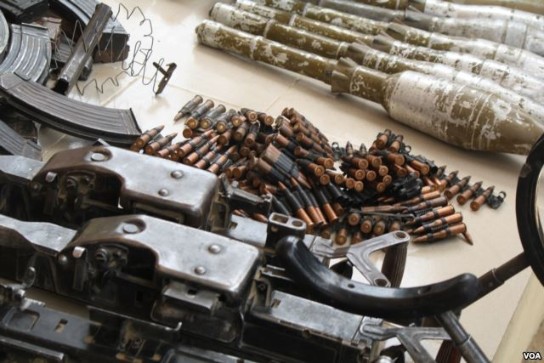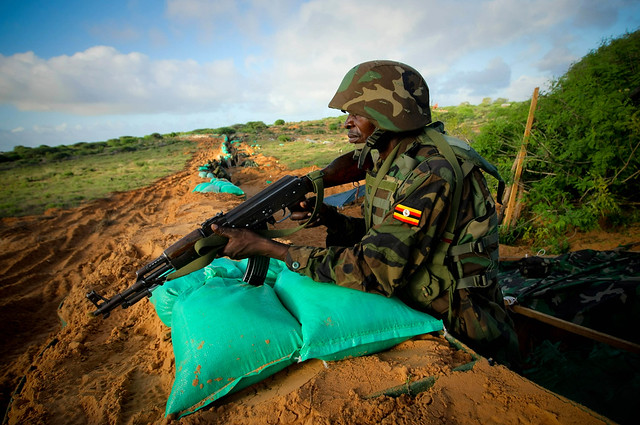 Captured Boko Haram Weaponry, Via Heather Murdoch/VOA
Captured Boko Haram Weaponry, Via Heather Murdoch/VOA
Critical Issues Facing Africa: Terrorism, War, and Political Violence
During 2014, along with the horrific outbreak of Ebola in West Africa, the continent as a whole experienced one of the more turbulent years in its recent history with widespread protests, unrest, civil wars, and insurgencies. The most recent flare-up of this new wave of violence resulted in Boko Haram’s deadliest attack ever, the massacre of an estimated 2,000 people in the northeastern village of Doron Baga.
In the wake of this attack, American policymakers must acknowledge the threats that ongoing conflicts in Africa have to the well-being, safety, and interests of the citizens of African states and those of U.S. citizens living and working abroad.
The more stable that Africa becomes, the better able the United States and its citizens will be able to pursue humanitarian and economic relationships with African states and their citizens. The more unstable that Africa becomes, the more the people of Africa will suffer at the hands of opportunistic, militant actors like Boko Haram and al Shabaab, the more volatility will manifest itself in world markets, and the less able the U.S. and its partners will be able to accomplish their humanitarian and developmental aims. Most troublingly, many conflicts currently taking place in Africa, like Boko Haram’s insurgency and the Second Libyan Civil War, are intensifying and spreading to surrounding states, increasing the risk of negative outcomes.
AMISOM Troops on Mogadishu’s Frontline (UN Photo/Stuart)
In this vein, the American Security Project (ASP) is proud to release “Critical Issues Facing Africa: Terrorism, War, and Political Violence,” featuring data from the Armed Conflict Location & Event Data Project (ACLED). This report blends together powerful quantitative and qualitative analyses to show how political violence in Africa unfolded during 2014, how it changed from 2013 – 2014, and how it will change going into 2015. Explore the data yourself through nine interactive charts.
The following three topics – “Overview of Political Violence in Africa During 2014”, “Trends in Political Violence in Africa Over Time”, and “Major Ongoing Conflicts in Africa During 2014 – 2015” – are at the core of Africa’s security challenge.
Overview of Political Violence in Africa During 2014
Deaths From Political Violence in Africa By Country, 2014
Main Takeaways: The African countries that suffered the most deaths from political violence in during 2014 are generally located near the southern coast of the Mediterranean Sea, the Sudan, the Sahel, the Horn of Africa, and the Niger River Delta.
African Countries That Suffered The Most Deaths
From Political Violence During 2014
Main Takeaways: The African countries that experienced the most deaths from political violence in 2014 are: 1) Nigeria, 2) South Sudan, 3) Somalia, 4) Sudan, 5) the Central African Republic.
Percentage of Top Five African Countries Out of
Total Deaths From Political Violence in 2014
Main Takeaways: Deaths from the countries that experienced the most deaths from political violence during 2014 – Nigeria, South Sudan, Somalia, Sudan, and the Central African Republic – constituted 75.5% of continent-wide deaths in 2014, suggesting a high level of concentration of conflict in a few specific areas.
Trends in Political Violence in Africa Over Time
Total Deaths From Political Violence In Africa, 2010 – 2014
Main Takeaways: Since 2010, the number of deaths from political violence in Africa has increased significantly. In this regard, 2014, with its rising numbers of deaths from political violence over 2013, was within an established pattern.
Nominal Change in Deaths From Political Violence in
Africa By Country, 2013 – 2014
Main Takeaways: The regions of Africa that experienced the highest nominal increases in the number of deaths from political violence from 2013 to 2014 are located in a latitudinal belt extending from the Niger River Delta in the West to South Sudan and the Horn of Africa in the East. There was also a pronounced increase on the southern coast of the Mediterranean Sea in Libya. The regions of Africa that experienced the highest nominal declines in the number of deaths from political violence from 2013 to 2014 are the Nile River Delta and Northern Sudan in the northeast and the Congo River to the south of the belt of increased violence.
Top Five Nominal Increases and Declines in Deaths
from Political Violence in Africa, 2013 – 2014
Main Takeaways: The African countries that experienced the highest nominal increases in deaths from political violence from 2013 to 2014 are: 1) Nigeria, 2) South Sudan, 3) Libya, 4) Cameroon, 5) Somalia. The African countries that experienced the highest nominal declines in deaths from political violence from 2013 to 2014 are: 1) Sudan, 2) Egypt, 3) the Democratic Republic of Congo, 4) Mali, 5) Ethiopia.
Percentage Change in Deaths From Political Violence in
Africa By Country, 2013 – 2014
Main Takeaways: The regions of Africa that experienced the highest percentage increases in the number of deaths from political violence from 2013 to 2014 are located in a longitudinal belt extending from the Niger River Delta in the South to the southern coast of the Mediterranean sea in the North. The northwest and northeast corners of the continent experienced small declines along with most of central Africa.
Top Five Percentage Increases and Declines in Deaths
from Political Violence in Africa, 2013 – 2014
Main Takeaways: The African countries that experienced the highest percentage increases in deaths from political violence from 2013 to 2014 are: 1) Cameroon, 2) Chad, 3) Libya, 4) Uganda, 5) Burkina Faso. The African countries that experienced the highest percentage declines in deaths from political violence from 2013 to 2014 are: 1) Angola, 2) Togo, 3) Guinea, 4) Eritrea, 5) the Republic of Congo.
Major Ongoing Conflicts in Africa During 2014 – 2015
Map of Major Ongoing Conflicts in Africa, 2014 – 2015
Main Takeaways:
Central Africa
The epicenter of political violence in Africa during 2014 was undoubtedly Nigeria, particularly its northeastern border with Cameroon, Chad, and Niger. Boko Haram’s insurgency cost thousands of lives, displaced countless more, and led to widespread devastation. The past year also saw Boko Haram expand its operations into neighboring Cameroon where security forces have faced challenges in containing its increasing strength and widening field of action.
Troublingly, it is becoming increasingly evident that neighboring Chad and Niger, which have already experienced large numbers of displaced persons and refugees from Nigeria, are being drawn into the conflict. As a result, the African Union, which has, in the recent past, deployed sizeable military forces to Somalia and Mali, is considering a new mission in the area to contain and rollback Boko Haram.
North Africa
To the North, Libya descended into civil war with a faction associated with General Khalifa Haftar and the National Government in Tobruk controlling the eastern half of the country and a faction associated with Libya Dawn (Fajr Libya) and islamist groups like Ansar al-Sharia controlling the western half.
As with Boko Haram’s destabilization of the entire Niger River Delta region, the nascent Second Libyan Civil War threatens to destabilize surrounding Egypt, Tunisia, and Algeria. Moreover, as the power vacuum in northeastern Syria was a crucial factor in the rise of ISIS, islamist groups may seek to increasingly co-opt the Libya Dawn coalition in the western part of the country or carve out their own areas of control and influence. There are some encouraging signs in nearby Egypt, Algeria, Mali, and Sudan, which have all seen declines in deaths from political violence during 2014, but still face sizeable ethnic and sectarian insurgencies of their own.
East Africa
To the East, the Central African Republic continued to suffer from a civil war between Seleka, Anti-Balaka, and Government militias. The Seleka, associated with militant Islam, and the Anti-Balaka, associated with militant Christianity and Animism, are attempting to force a breakup of the country along sectarian and ethnic lines with the country’s population caught in the fatal crossfire.
In neighboring South Sudan, civil war between factions associated with the country’s Dinka and Nuer tribes intensified while, to the north, fighting between South Sudanese separatists and the government of Omar al-Bashir declined, but still constituted a major conflict. Farther to the East in Somalia, fighting between the African Union Mission in Somalia (AMISOM) and the islamist, militant group al Shabaab also intensified.
Southern Africa
To the South, the Democratic Republic of Congo’s endemic strife calmed while the number of deaths from political violence in Uganda increased.
Other than civil strife in South Africa, most of the continent’s southern tip saw both low levels of deaths from violence and little change in the total numbers of deaths from the previous year. However, off the eastern coast of Africa, Madagascar has experienced a marked increase in deaths, particularly involving a number of insurgent Dahalo militias.
Conclusions and Executive Summary
Overall Trends
During the past few years, violence in Africa has, undoubtedly, increased from its recent historic levels. Moreover, it is clear that the current phase of this violence is highly concentrated in a small number of high-profile conflicts: the Boko Haram insurgency in Central Africa, the Second Libyan Civil War to the north of the Sahara, and the al Shabaab insurgency in the continent’s eastern horn.
This violence has predominantly taken the shape of 1) conflicts between sectarian and ethnic insurgent groups and state governments and 2) civil war between various coalitions of sectarian and ethnic groups fighting for control of the state itself.
While this article’s quantitative analysis is limited to the number of people killed in conflict, there is strong evidence to suggest that the personal suffering of African citizens injured or displaced and the loss of potential development and economic opportunity from the instability that high levels of violence engenders are substantial, if not increasing as well.
Importantly, as with ISIS, many groups latch onto larger organizations like Boko Haram and al Shabaab not necessarily because they believe in their ideology, but rather because they possess the strongest, relative organizational structure and, thus, represent the best conduit for these groups to achieve their separate objectives. At the same time, these groups risk being co-opted by the larger organization and ideology that they believe they can restrain and control.
What Is To Be Done?
During a time in which advances in communication, economic integration, and political solidarity find the world’s many nations drawn together into a closely-knit network, both the emerging and persistent threats to the security of Africa constitute a threat to all, especially the United States.
In consideration of the analyses presented in these articles, U.S. policymakers and citizens must consider seriously these threats and work to devise effective solutions.
If You Like This Article, Please Check Out More:
What’s in a Name?: Boko Haram renames itself the Islamic State’s West Africa Province (ISWAP)
Critical Issues Facing Africa: Governance & Corruption
Four Maps that Explain Islam in Africa







please my question is how those weather and climate contribute to the insecurity most especially in Nigerian
Alu – check out – https://www.americansecurityproject.org/climate-security-report/
Very informative article! Thank you for sharing.
Kudos to the researchers on these deadly issues
A quick peek at the aftermaths of 2007 post election violence in Kenya, ahead of the oncoming 2017 general election. Get your copy here:
https://www.amazon.com/Diary-I-D-P-schooling-post-election-violence-ebook/dp/B01BAZBF7K
[…] following three topics – “Overview of Political Violence in Africa During 2014”, “Trends in Political Violence in Africa Over Time”, and “Major Ongoing Conflicts in Africa During 2014 – 2015” – are at the core of […]